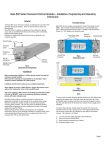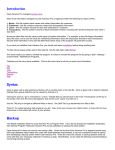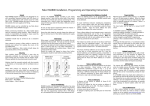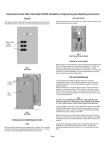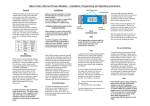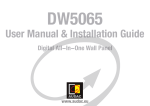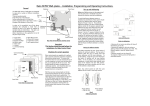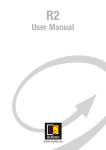Download Rako RML1200 Dimmer Modules – Installation
Transcript
Rako RML1200 Dimmer Modules – Installation, Programming and Operating Instructions. Rako RML1200 is a digital, hard-fired, leading edge dimmer module suitable for use with mains voltage tungsten lighting, low voltage tungsten with appropriate transformers and cold cathode lamps. Rako RD dimmer modules are designed to be installed in a lighting circuit and are controlled from Rako scene-sender panels transmitting Rakom encoded radio signals. Setup Button Aerial Fixing hole LED Supply Terminals Installation Before commencing installation of a Rako dimmer module first read this instruction manual carefully. Rako Controls Ltd accepts no responsibility for any damage or injury caused by incorrect installation of a Rako product. Installation should only be carried out by a competent electrician. Never attempt to connect a Rako dimmer or remove the terminal covers without first isolating the circuit at the fuse/MCB board. The circuit supplying a Rako dimmer should always be protected by either a 5A fuse or 6A MCB. Under no circumstances should any protection devices with higher ratings be used. Always mount the unit vertically and ensure that the ventilation slots are not covered. Whilst the Rako dimmer modules are designed to be completely maintenance free the units should be mounted in a position where access can be gained should there be a fault or re-addressing of the unit be necessary (see ‘Set-up and Addressing’). Permissible loadings. Mains voltage tungsten – full rating i.e. 1200w. Transformer fed loads, allow 10% derating, i.e. 1080w of nominal lamp load. Note: In the case of transformer fed loads only transformers suitable for use with leading edge dimmers should be used. If in doubt contact the Rako customer help-line on 01634 226666. Connection To install a Rako dimmer module isolate the supply then undo two screws to remove the lid, giving access to the supply/load terminals. The necessary Fuse Fixing hole connections are indicated on the main circuit board. The notation is as follows: Load Terminals Cable Clamp lighting switch can also be used as an override in the event that the batteries in a Rako control panel are not replaced when the low-battery warning signals indicate that this should be done. Set-up and Addressing Before any lighting scenes can be programmed (see the wall panel or handheld instruction manual) the receivers need to be addressed. SUPPLY Fig 2. Connection Detail LOAD The cables should be secured using the two cable clamps fitted to the base of the unit. Note: To ensure that the cable clamping operates satisfactorily the cabling both supplying the dimmer and to the load should be a minimum of 1.0mm 2 with double safety insulation and the wires should be stripped to ensure that the cable bar within the terminal cover clamps firmly on both sets of insulation. Alternative cable exit can be achieved through the rear face of the unit. A knockout area is provided in the plastic next to each of the terminal blocks. Once the supply and load cables are connected replace the lid securely before restoring power to the unit. Rako dimmer modules are not designed for loop in/loop out connections. Should it be necessary to loop the supply on to further fittings then a junction box should be connected in circuit to facilitate this. When power is connected the Rako unit will fade to a full-on setting. In this way it is possible to leave a conventional lighting switch in circuit to simply fade between full-on and off settings without the use of a Rako control panel. Such a To avoid interference between rooms or neighbouring installations a Rako system should be set to an address other than the factory default of House 1 Room 4. The preferred addressing method is to select a logical House address number for the project, separate Room addresses for each room within the house and then sequential Channel numbers for each receiver within each room (see Fig.5) i.e. Channel 1 for the 1 st receiver, Channel 2 for the 2 nd etc. The House and Room addresses are set using the DIP switches on the back of a Rako controller (see Fig.4) and the Channel address is set by ‘stepping’ through the channel numbers with a panel in programming mode (see Step 3 overleaf) and then sending this number (along with the House and Room address) to a receiver (Step 5). Setting the address switches. Each Rako transmitter has two, 8 way banks of switches for setting its address. The two sets of switches allow the user to choose from 256 house addresses and 256 room addresses. To set the address, unclip the rear cover whereupon the banks of switches will be now become visible. To set an address, use a small terminal screwdriver or similar device and carefully move some of the switches into the ‘ON’ position. Addressing uses binary encoding and the value of the switches is shown below. House address = 128+16=144 ROOM 128 64 32 16 8 4 2 1 Initial Addressing of RML1200 Dimmer In the following procedure both the controllers (wallpanels and hand held remotes) and the receivers have an automatic time out after approximately 3 minutes when in programming or set-up mode. This feature avoids the possibility of either being left permanently in programming or set-up mode. This may cause confusion if either the controller or receiver times out before the procedure is complete. It is worth becoming familiar with the procedures before starting the addressing procedure. If at any time it is necessary to start again the controllers can be returned to normal mode by pressing the ‘Off’ button and the receivers by resetting the electrical supply. Step 2 O N B IN A R Y V A L U E H O U SE 128 64 32 16 8 4 2 1 O N B IN A R Y V A L U E Note: Any control panels set with the same address will act as two or multi way controls. Room address = 32+4=36. Fig 3. Addressing Switches Step 1 Put controller into programming mode. Set Address switches on controller Pick a House Address from 1-255 (keep same address for all panels in house) Select Room Addresses from 1-255 for each room. (Room 0 is Master House control) Channel 2 House 144 Room 6 Channel 1 TIP Press the scene button first Press and hold a scene button and both raise & lower buttons together, After 5 seconds the LED on the panel starts to flash. The panel is now in Programming Mode. Release the buttons Table 1 Note: ButtonAction 1Step up one & enter programming mode at Channel 0. It is not possible to give a receiver an address of Channel 0, but this gives a consistent starting point A Rako panelchannel will always Ident 2Step down one channel & Ident 3Ident 4StoreNo action OffExit Channel 2 House 144 Room 5 Channel 1 NO programming Note: When in Programming Mode the buttons have functions as detailed in table 1. 144 YES Fig 5. Addressing Example Notes on addressing. A module will not receive an address of House 0 (All switches set to off) A dimmer will respond to, but not receive an address of Room 0 (All switches set to off). This Room 0 address is used for ‘Master House’ control A dimmer cannot be set to channel 0. To program a lighting scene see Wall panel or Hand held manual. Care and maintenance A Rako receiver module contains no user serviceable parts. Should for any reason you need to contact us please contact us via our website www.rakocontrols.com or by phoning our customer help line on 01634 226666 Step 3 Press button 1 once to step up one channel. If this is the desired channel i.e. Channel 1 (for the 1st receiver) then go to Step 4. If not, press button 1 again to step up to channel 2 (for the 2nd receiver), press again to step to channel 3 etc until the desired channel number is reached (maximum = 15). It is this channel number (along with the House and Room address) that is sent to the receiver in step 5. If it necessary to step down a channel at any point, press button 2 once Is the Controller Still in programming Mode (LED still flashing)? If some receivers are already addressed to a the wall panel then they will ‘flash’ their connected lamps as their channel number is reached during the stepping procedure, this allows the user to ‘identify’ which channel numbers are already taken. To add a new receiver to an existing installation step up through the channels until a channel number is reached where no receiver flashes a load, this is then an available channel. If at any point there is uncertainty as to whether a receiver actually flashed its load then button 3 will flash the load but without stepping up or down a channel. If all of the loads flash then this indicates that the current address is Channel 0. Note: If it is not possible to see the connected lamps flashing when stepping through the channels it is possible to tell from the LEDs in the receivers which will momentarily go solid when their channel address is reached. Go to the receiver to be addressed YES Step 4 Is there another receiver in the room to be addressed? Remove the top cover from the upper part of the RDL1200 case. Use a slim tool to push the ident button that is located down the ident access hole in the case. A blue LED will illuminate inside the case, visible through the case vent holes. Hold the button down for 5 seconds & the LED will start to flash, release the button. LED continues to flash indicating that dimmer is in Programming Mode Step 5 Press the button 3 to send the ident of the channel selected in Step 3. The dimmer will automatically return to normal mode (it’s blue LED goes out). The controller will remain in Programming Mode ready to ident further dimmers. NO Step 6 Press the Off button to exit the controller from Programming Mode


